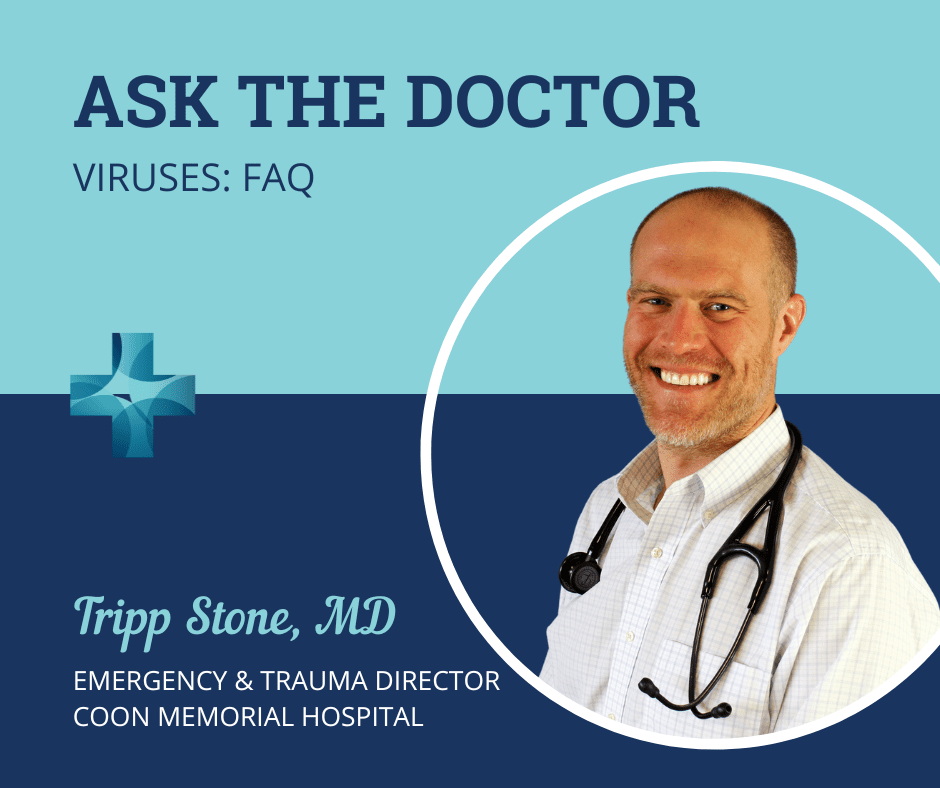Dalhart Community,
As the weather warms up, many of us feel a sigh of relief that viruses will soon be in the rearview mirror. Unfortunately, that is NOT the case. While it is true that viruses and their rates of infection are higher in the winter months, viruses can strike at any moment. Paradoxically, although many of the common viruses that are prevalent in our community are usually self-limited and benign, they can often make us feel the worst!
 Viral symptoms are bountiful. Runny nose, scratchy throat, itchy eyes, cough, earaches, muscle aches, headaches, fever, nausea and vomiting, as well as diarrhea are all common symptoms experienced by patients with viruses. In fact, the combination of all these symptoms may often lead your provider to suspect a viral illness. In contrast, bacterial illnesses often, but not always, present with fewer, more isolated symptoms. While children are often the demographic most affected by viral infections, they are certainly not the only demographic at risk. We are all susceptible to their fury!
Viral symptoms are bountiful. Runny nose, scratchy throat, itchy eyes, cough, earaches, muscle aches, headaches, fever, nausea and vomiting, as well as diarrhea are all common symptoms experienced by patients with viruses. In fact, the combination of all these symptoms may often lead your provider to suspect a viral illness. In contrast, bacterial illnesses often, but not always, present with fewer, more isolated symptoms. While children are often the demographic most affected by viral infections, they are certainly not the only demographic at risk. We are all susceptible to their fury!
How long should I expect to be sick?
Great question. A rough estimate would be 3-10 days. It could be less or it could be more.
How do I treat it?
Another great question. Despite many of the advances in modern medicine, viruses maintain their ability to evade our ability to combat them. With VERY few exceptions, there are no targeted therapeutics or “cures” for many of the common viral illnesses. This is the result of a multitude of factors. As such, many of the treatments for viral infections are supportive. In fact, because there are few therapeutics and because they are generally benign/self-limited, testing to diagnose the virus of interest is often not indicated.
What is “supportive care”?
Supportive care is essentially the practice of alleviating symptoms or supplementing deficiencies when noticed. For example, if a small child is ill with a virus such as RSV, they will often experience fevers, increased mucous production, and the most feared complication, increased work of breathing or low oxygen levels. So while there may not be a medication that “kills” the virus, treatment is aimed at alleviating the aforementioned symptoms/problems until the patient’s immune system fights off the illness. So in our example patient with RSV, Tylenol would be indicated for fevers (please see prior post on fever!), bulb suctioning as well as mucolytics (ie Mucinex) for mucous production, and if the patient has increased work of breathing or low oxygen levels, oxygen! These therapies do not have any activity against the virus itself, but they help bridge us along until the immune system kills it. Your provider’s decision whether or not to bring a patient into the hospital is often dictated by the level of support a patient needs.
Below you will find a link to CHOP (Children’s Hospital of Philadelphia); one of the nations leading premier pediatric institutions. The link discusses upper respiratory infections which is the common locale of infection from viruses. Please review it as it provides more helpful information than the above post. As always, please write in with any questions or concerns you may have and we will do our best to answer them in a timely manner. You can submit your questions to heydoc@dhchd.org.
Upper Respiratory Infection (URI or Common Cold) | Children’s Hospital of Philadelphia (chop.edu)
Stay healthy,
Dr. Stone
Of note, while this post and link concentrated on viral upper respiratory infection, the same principles (ie supportive care) apply to viral infections elsewhere in the body.
